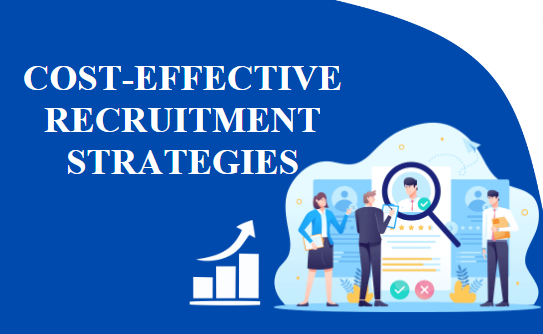In recent modest job market, finding the right talent for your organization can be a scary task. Companies are continuously looking for innovative ways to align their recruitment processes while keeping costs in check. This comprehensive article will elaborate some cost-effective recruitment tactics to help you attract, hire, and retain top talent without breaking the bank.
Cost-Effective Recruitment Strategies
Leveraging Employee Referrals
Your current employees can be your best recruitment resource. Encourage them to refer qualified candidates for open positions. Offer incentives to motivate them, such as referral bonuses or recognition.
One effective way to adopt this strategy is by creating an employee referral program. Provide clear plans on how referrals should be made and reward employees when their referrals result in successful hires.
Optimizing Your Company Website
Ensure your website is user-friendly and showcases your company culture and career opportunities. Implement an easy-to-navigate careers page, complete with job listings and an application process that’s straightforward.
Additionally, regularly update your website with engaging content that highlights your company’s mission, values, and success stories. This can attract potential candidates who resonate with your organization’s ethos.
Harnessing the Power of Social Media
Employ platforms like LinkedIn, Facebook, and Twitter to share job introductions, interact with potential candidates, and build your employer brand. Social media can be a gainful way to reach a far-reaching audience.
Create interacting posts that provide visions into your company’s culture, employee references, and career building opportunities. Encourage your employees to share these posts within their networks to increase visibility.
Read Also: Top Tech Tools for Small Businesses
Utilizing Job Boards and Niche Websites
Consider both general job boards and niche websites related to your industry. These platforms can help you target specific candidates and reduce recruitment costs.
When posting on job boards, craft compelling job descriptions that not only outline the role’s responsibilities but also highlight your company’s unique selling points. This will attract candidates who align with your organization’s values.

Networking and Industry Events
Attend industry conferences, seminars, and networking events to connect with potential candidates. Building relationships in your industry can lead to valuable referrals.
While at these events, don’t focus solely on recruitment; aim to establish your company as an industry leader. Sharing your knowledge through presentations or workshops can make your organization more attractive to potential hires.
Internship Programs
Offering internships not only provides valuable experience to students but can also serve as a talent pipeline for future hires. Interns who fit well with your company culture can transition into full-time employees.
To make your internship program cost-effective, structure it as a win-win. Provide interns with mentorship and learning opportunities while benefiting from their fresh perspectives and contributions.
Collaborating with Educational Institutions
Partner with local colleges and universities to establish relationships with professors and career services offices. This can lead to access to a pool of talented graduates.
Consider offering workshops, seminars, or guest lectures at these institutions to showcase your industry expertise. Such initiatives can make your company more appealing to students seeking career opportunities.
Implementing Applicant Tracking Systems
Invest in applicant tracking systems (ATS) to streamline your recruitment process. ATS can automate tasks like resume screening, reducing administrative costs.
When selecting an ATS, choose one that integrates well with your existing HR software and provides robust reporting and analytics capabilities. This will enable you to track the efficiency of your recruitment efforts.
Employee Training and Development
Devote in training and development programs for your existing employees. When employees see opportunities for progress, they are more likely to stay with your organization, reducing revenue.
Offer online courses, workshops, and counselling programs to improve your employees’ expertise and awareness. This not only benefits your current workforce but also enhances your reputation as a company that values employee development.
Read Also: The Indispensable Role of Business Planning in 2023
Promoting a Positive Company Culture
A positive workplace culture can be a powerful recruitment tool. Candidates are more likely to apply to and stay with companies that value their employees’ well-being.
To cultivate a positive culture, prioritize open communication, recognition, and work-life balance. Share stories of employee successes and well-being initiatives on your website and social media to showcase your company’s commitment.
Flexible Work Arrangements
Offering flexible work options, such as remote work or flexible hours, can attract candidates seeking work-life balance. This can be a cost-effective benefit.
Outline clear policies and expectations for flexible work arrangements to ensure they benefit both employees and the organization. Regularly assess the impact of these arrangements on productivity and employee satisfaction.
Outsourcing Recruitment Processes
Consider outsourcing certain recruitment tasks, such as background checks or initial screenings. Outsourcing can save time and money in the long run.
Before outsourcing, carefully vet potential partners to ensure they align with your company’s values and standards. Establish clear communication channels to maintain control over the recruitment process.
Data-Driven Decision Making
Utilize data analytics to assess the effectiveness of your recruitment strategies. Make data-driven decisions to optimize your processes and reduce costs.
Regularly review key performance indicators (KPIs) such as time-to-hire, cost-per-hire, and applicant conversion rates. Use these insights to fine-tune your recruitment approach and allocate resources efficiently.
Measuring and Adjusting Your Strategies
Regularly evaluate the success of your recruitment efforts. Adjust your strategies based on what works and what doesn’t to continuously improve your cost-effective recruitment approach.
Seek feedback from candidates and employees to gain insights into your recruitment processes. Implement changes based on this feedback to enhance the candidate experience and improve retention rates.
Conclusion
Recruitment doesn’t have to drain your resources. By applying these gainful strategies, you can find and retain top talented candidates while staying within your budget. Remember that recruitment is an unending process, and adjusting to changing trends is key to long-term success.
In conclusion, cost-effective recruitment is not only reachable but also important for supportable business growth. By following the strategies outlined in this guide and expanding upon them, you can build a talented and dedicated workforce without straining your budget.
